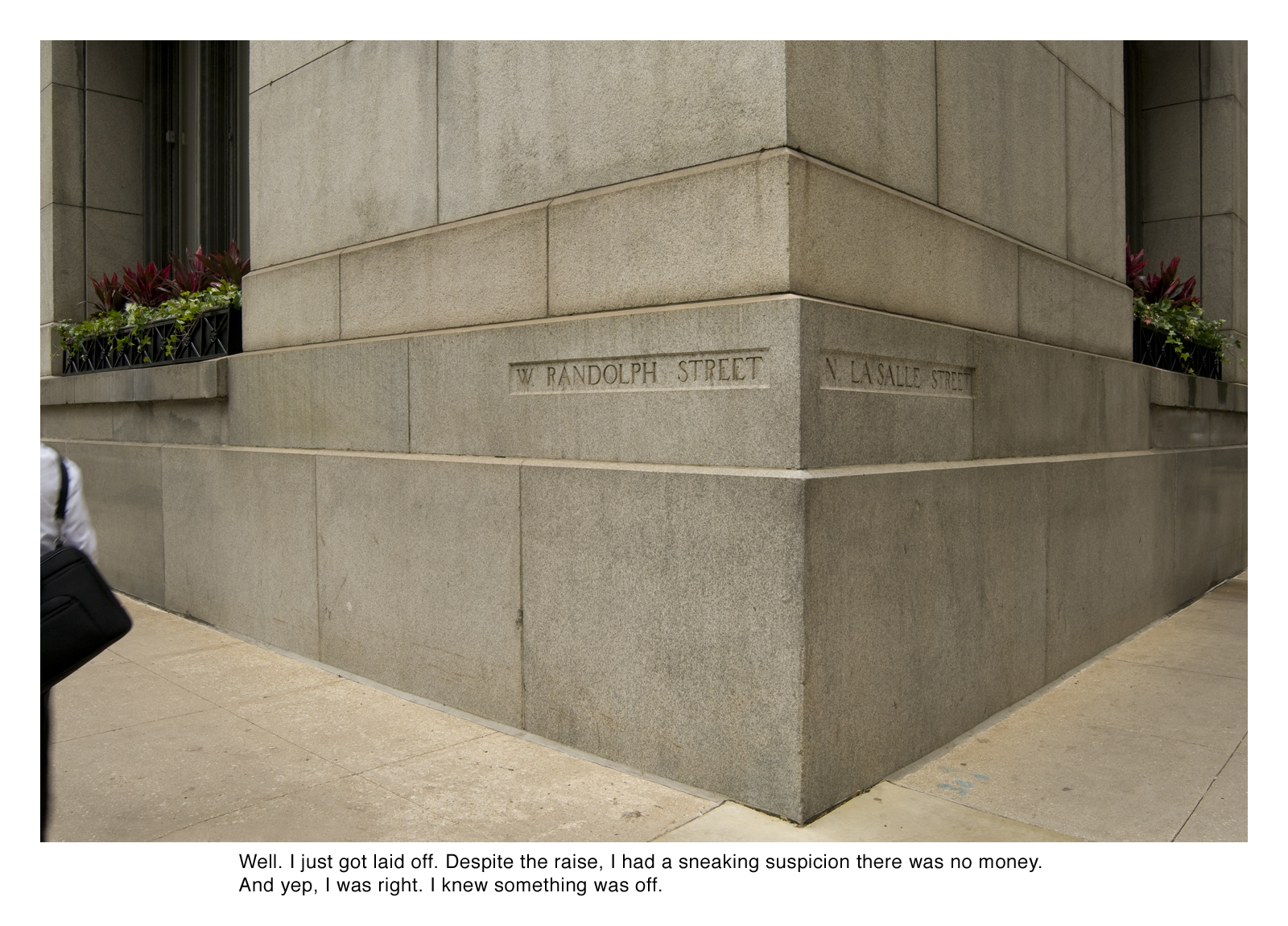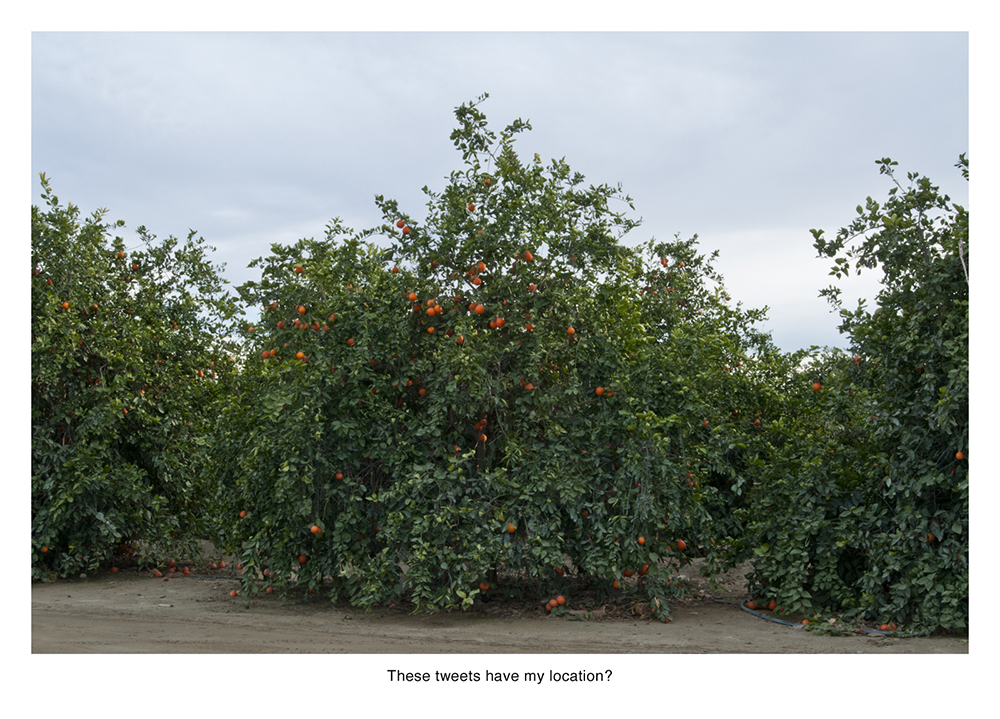Marni Shindelman and Nate Larson are two artists who collaborate on projects focussed on perceptions of time and space in modern life and in relation to social networks. Their most recent series of projects, Geolocation, involves the two choosing tweets which are tagged with location information, photographing the actual spot where the tweets were made, and then pairing the original tweets with their new images. They say the photographs "anchor and memorialise the ephemeral online data in the real world and also probe the expectations of privacy surrounding social networks." We think the photographs are beautiful, powerful, and slightly creepy, in a really great way. We were so intrigued, we had to have a chat with Nate and Marni about the work.
Annons
VICE: How did this project come about?
Marni Shindelman: Nate and I were working on a project called Semaphore, in which we were translating text messages into semaphore flag language. We found one tweet on an old mashup app that had a GPS coordinate on it near where we were shooting. We shot our first Geolocation photograph "Sneaking Suspicion" at that spot. At that moment, we knew right away we had started a much larger project. The technology caught up to us with the popularity of FourSquare and other locative games.Nate Larson: It's been an interesting time to think about these issues of privacy and over-sharing, especially with the way that the technology has become so common and widely affordable. We see the project as a social document, preserving fragments from this moment in history and linking the disconnected internet data back to its point of origin.
Marni Shindelman: Nate and I were working on a project called Semaphore, in which we were translating text messages into semaphore flag language. We found one tweet on an old mashup app that had a GPS coordinate on it near where we were shooting. We shot our first Geolocation photograph "Sneaking Suspicion" at that spot. At that moment, we knew right away we had started a much larger project. The technology caught up to us with the popularity of FourSquare and other locative games.Nate Larson: It's been an interesting time to think about these issues of privacy and over-sharing, especially with the way that the technology has become so common and widely affordable. We see the project as a social document, preserving fragments from this moment in history and linking the disconnected internet data back to its point of origin.

How do you select the tweets?
Marni: We used editorial instinct in the early work. It all falls into a number of categories—leaving work, sentimental, political, and ones referencing the media. In our latest portfolio, #HowToKeepARelationshipWithMe, we looked at trending hashtags in New York City during a week in July. “#HowToKeepARelationshipWithMe” was trending at that time and we photographed every tweet with a GPS coordinate embedded in it within a 15 mile radius of Manhattan. This eliminated the subjectivity of selecting the tweets.
Marni: We used editorial instinct in the early work. It all falls into a number of categories—leaving work, sentimental, political, and ones referencing the media. In our latest portfolio, #HowToKeepARelationshipWithMe, we looked at trending hashtags in New York City during a week in July. “#HowToKeepARelationshipWithMe” was trending at that time and we photographed every tweet with a GPS coordinate embedded in it within a 15 mile radius of Manhattan. This eliminated the subjectivity of selecting the tweets.
Annons
Nate: In the earlier work, I was drawn most to ones that said something about the moment in society that we were living in — topics like the economy, health care, or politics. Marni was attracted to ones that were overly sentimental or referencing pop culture. Both of us loved the ones about technology and loneliness. People are more connected than at any point in history, but we found a very large quantity of tweets about loneliness and longing.Have you ever met or heard from someone whose tweet location you documented?
Marni: No, but we wish we would! We just finished an installation of the project on large billboards around Atlanta. The tweets we used were within a half mile radius of each billboard. Sadly, we didn't hear from any of our tweeters.Do you think people are aware of the trail of digital artifacts they leave behind with things like Twitter or Foursquare?
Marni: I think people have a limited knowledge of their data trail. What they don't understand is the ease at which someone can connect the dots of their digital path to gain more access to their data. In our work, we’re not hacking or using privileged information. This can all be done over the internet or a smartphone utilising public data.Nate: It's also interesting to think about the slippage between the moment you set privacy settings and then a year or two later. Personally, I suspect that over time people forget the level of information they put out publicly. And, in the case of our project, I think that's when it gets really interesting.
Marni: No, but we wish we would! We just finished an installation of the project on large billboards around Atlanta. The tweets we used were within a half mile radius of each billboard. Sadly, we didn't hear from any of our tweeters.Do you think people are aware of the trail of digital artifacts they leave behind with things like Twitter or Foursquare?
Marni: I think people have a limited knowledge of their data trail. What they don't understand is the ease at which someone can connect the dots of their digital path to gain more access to their data. In our work, we’re not hacking or using privileged information. This can all be done over the internet or a smartphone utilising public data.Nate: It's also interesting to think about the slippage between the moment you set privacy settings and then a year or two later. Personally, I suspect that over time people forget the level of information they put out publicly. And, in the case of our project, I think that's when it gets really interesting.
Annons

This has been a site-specific series of projects. Have you noticed major differences in tweets depending on location?
Marni: Not as much as one would imagine. When we are in different locations, we try and find tweets or language that might be specific to the region we are in. But across the board, people tweet about wanting to leave work, news, love, and tragedy. We tend to ignore the vast number of advertising tweets that fill the feeds.Nate: So far, we've worked in countries like the UK and Canada that are culturally linked to the US. We're actively seeking sponsorship to travel beyond western culture in hopes of uncovering deeper differences.What’s it like to collaborate with a partner on an artistic project?
Marni: Having a collaboration is like whispering your darkest habits and bizarre thoughts to a friend. It's nerve-wracking. Art making is about exploring ones way of seeing the world, and this means examining all the quirks and oddities of your daily habits and telling someone else. Rather than being very similar, our ideas play well off each other. That’s what has made our collaboration so fruitful. When working out a new methodology for making images, it is hard to remember where those ideas came from. It usually starts with one of us having what we think is a weird or silly idea. We then work on that and begin to progress the concept. The actual photographs often are not taken together, but the editing process is always done together, to keep consistency between the text and images. And we utilise all digital means of collaborating to make it easier for us to work cohesively.
Marni: Not as much as one would imagine. When we are in different locations, we try and find tweets or language that might be specific to the region we are in. But across the board, people tweet about wanting to leave work, news, love, and tragedy. We tend to ignore the vast number of advertising tweets that fill the feeds.Nate: So far, we've worked in countries like the UK and Canada that are culturally linked to the US. We're actively seeking sponsorship to travel beyond western culture in hopes of uncovering deeper differences.What’s it like to collaborate with a partner on an artistic project?
Marni: Having a collaboration is like whispering your darkest habits and bizarre thoughts to a friend. It's nerve-wracking. Art making is about exploring ones way of seeing the world, and this means examining all the quirks and oddities of your daily habits and telling someone else. Rather than being very similar, our ideas play well off each other. That’s what has made our collaboration so fruitful. When working out a new methodology for making images, it is hard to remember where those ideas came from. It usually starts with one of us having what we think is a weird or silly idea. We then work on that and begin to progress the concept. The actual photographs often are not taken together, but the editing process is always done together, to keep consistency between the text and images. And we utilise all digital means of collaborating to make it easier for us to work cohesively.
Annons
Do you have your own twitter(s)?
Marni: Mine is @marnimcfly and Nate's is @natelarson. But neither of us geotgag our tweets.Well, I could have guessed that.Check out more of Marni and Nate's work here.
Marni: Mine is @marnimcfly and Nate's is @natelarson. But neither of us geotgag our tweets.Well, I could have guessed that.Check out more of Marni and Nate's work here.
